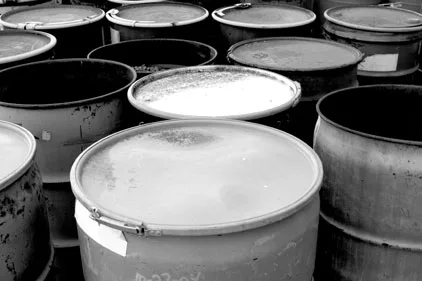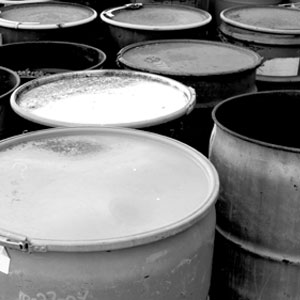Solids, Liquid Disposal in Environmental Drilling Not a Guessing Game

One of the scariest terms an environmental driller may face is IDW (investigation derived waste): the solid and liquid material generated by the drilling activity. The containment, testing, transportation and disposal of IDW can be a significant part of a project cost. Typically, drillers do not have to worry about the cost for the ultimate disposal of the waste. However, for bidding purposes and for the client’s disposal cost, we need to accurately determine the amount of waste generated during our drilling operations.
Let’s start with a simple example: a small, hollow stem auger drilling project at a service station. The work consists of the installation of three monitor wells, constructed of 4-inch, schedule 40 PVC to a depth of 25 feet. All waste from the project will be stored in 55 gallon drums. Now, let’s determine the number of drums needed for the work.
Assuming we use standard size augers (6-inch inside diameter by 10-inch outside diameter), we estimate generating about 0.6 cubic feet of cuttings for every 1 foot of hole drilled. Therefore, this project should produce about 45 cubic feet of waste: three holes times 25 feet deep times 0.6 cubic feet per foot of hole drilled. Figuring that a 55 gallon drum will hold about 7 cubic feet of solids means that the total number of drums we need is 7 (the actual number is 6.4 drums, but we can’t buy 0.4 drums). The math is simple, right? Well, not so fast. Let’s get a little more detailed in our analysis.
While it is true that standard 6-inch ID augers have an OD of 10 inches, the cutting head is most likely about 11 inches in diameter (if your welder/driller modified the cutting head, it could be much bigger). Also, the augers normally wobble in the hole, making the bore slightly larger than the OD of the cutter head. Finally, have you ever dug a hole and then tried to fill it back up again? You always have dirt left over because the soil was compacted and you loosened it during digging. All of the above means that you will generate more cuttings than you expect.
So, what to do? Use a fudge factor. What I have found during my career is that for auger projects, using the OD of the cutting head (not the augers) and adding about 25 percent will keep me out of trouble. Therefore, the correct calculation would be: three holes times 25 feet deep times 0.7 cubic feet per foot of hole drilled (remember, 11-inch hole diameter) for a total of 52.5 cubic feet. This would then lead to 9 total drums for waste. Finally, we have this calculation complete—not hardly.
 . . |
|
Waste barrels can add up quickly depending on local rules—and sometimes client preferences—for liquid and solid materials disposal. Source: iStock |
We calculated the total amount of solid waste for the project. Now, let’s talk about liquid waste. That can’t be that much, you think. Well, maybe it could be. We will start with decontamination water. Remember, the augers need to be cleaned between holes. “But I brought 75 feet of augers with me on the support truck,” you say. OK, then all 75 feet of augers need to be cleaned at the end of the job. Assume that you have a steam cleaner, which is really not a steam cleaner at all, but a high-pressure, hot-water washer. The kind I normally use produces 2,000 psi at 3.5 gpm. Each 5-foot auger takes about 4 minutes to clean. That means we have now generated about 210 gallons of decon water: 4 minutes per auger times 15 augers times 3.5 gallons per minute. We just added another four drums to the total.
You have to be very careful with this estimate. If you are working in an area with really sticky clays, like Houston, the amount of time to clean the augers could double. We are now up to 13 drums for this project. But we’re not done with the liquids yet.
Well development water also needs to be contained and potentially disposed of. How much development water will we have? That depends on the project specifications. Sometimes we need to meet very particular parameters based on dissolved oxygen and turbidity. Other times, it is a simple well volume calculation; the client will ask for three well volumes to be removed from the well. What the heck is a well volume? We are talking about the amount of water in the borehole. But how do we calculate it? Citing the example above of a 25-foot deep well, let’s assume the water in the well is at 18 feet below ground surface (bgs). That means we have roughly 7 feet of water in the well. However, we also have filter pack in the hole. So, an accurate determination of the development water for one well would be:
• Volume of water in the 4-inch PVC well – 7 feet of saturated thickness x 0.7 gallons/foot = 4.9 gallons
• Volume of water in borehole – 7 feet of saturated thickness x 4.0 gallons/foot x 0.30 (porosity of gravel pack) = 8.4 gallons
• Total water volume generated for one well is 4.9 gallons + 8.4 gallons = 13.3 gallons x 3 well volumes = 39.9
Now, we just generated another 120 gallons of waste during well development activities—three more drums for a total of 16. Whew … now we’re done, right? Not for some clients.
When we built the well, we mixed and pumped a cement/bentonite grout for the well seal, and we also constructed well pads. During that process, we washed out our cement pump and other tooling that came in contact with the cement. Used to be we would either pump the wash water to the storm drain or add it to the development or decon fluids. Not anymore. Because that fluid came in contact with cement, that wash water is basic — sometimes up to 11 on the pH scale. Some consultants and/or owners either want that fluid as a separate waste stream or would like that high pH fluid neutralized with an acid, like vinegar. So, we just added one more drum of liquid waste for a total of 17 drums for the project.
Will all of these drums need to be transferred to a disposal facility? Probably not. If the decon/development and wash water are not contaminated and meet discharge requirements, they may just be poured into the storm drain or sanitary sewer. If the cuttings are clean and regulations permit, the material could be used as clean fill on the site.
We all have our rules of thumb when figuring how to estimate the number of drums for a particular drilling project. How does your SWAG match up with the calculations we just went through? One more thought: How would you calculate waste containment for a 300-foot deep, 10-inch extraction well, drilled mud rotary? Let’s leave that for another month’s column.
Looking for a reprint of this article?
From high-res PDFs to custom plaques, order your copy today!








